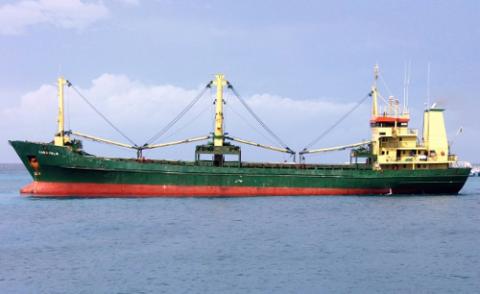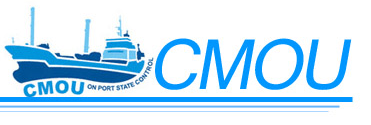Carib Palm

Ship's particulars
| Name: Carib Palm | Type of Vessel: Gen.Cargo / Multipurp. |
| IMO No: 7623083 | Kiel date: 1977 |
| Call Sign: ERZN | Gross Tonnage: 1467 |
| Flag: Republic of Moldova | ISM Company: Blue Marine Shipping CO Ltd. |
| Classification Society / RO: MSR | Owner: Blue Marine Shipping CO Ltd. |
Summary of Inspection:
The vessel called the port of Oranjestad in St Eustatius to take bunkers at the anchorage and was enroute from Dominican Republic to Gdanks in Poland. The vessel was selected for inspection because information reached the NSI that a small oil spill during bunker operations occurred the night before. Also the fact that she sailed the flag of the Republic of Moldova which is on the Paris MOU black list of flags and considered as high risk Flag State.
During the inspection 25 deficiencies were identified of which 11 were ground for detention.
Among the detainable items were:
- The Cargo Ship Safety Construction Certificate missing.
- One 9GHz radar missing.
- Gyro compass out of order.
- Fire man’s outfits not complete and not ready for use.
- The nautical publications needed for the intended voyage were outdated from year 2000.
- The rescue boat was not ready for use.
- Emergency fire pump was not delivering water.
- Oil filtering equipment not installed.
- Hatches from the cargo holds not WT.
- Closing devices from the ballast and fuel tanks not closing properly.
- No drills executed by the crew.
Inspection Information:
The inspection started with checking of the vessels certificates and documents.
During this check, it appeared the CSSC certificate was missing. The vessel recently changed flag, class, management and owner and all statutory certificates were newly issued. The change of flag requires a new LRIT conformance test. Only the report from the previous flag was on board, the new LRIT conformance test report could not be presented. Also the Declaration of Maritime Labour Compliance part II was missing.
The master was instructed to present at least evidence the missing documents were issued to the vessel before completion of the PSC inspection in order to avoid detention of the vessel. He failed to do so and the absence of the CSSC certificate resulted in a detainable deficiency, the missing LRIT report and DMLC II were given a code 17.
The inspection continued on the bridge. A first impression of the chart table showed all the charts used fort the navigation were new editions and up-to date but the nautical publications on the book shells were all from the year 2000. There was no voyage plan available. Although on the CSSE form E stated the vessel is equipped with two radars only one 9GHz radar was installed. Cables on the bridge and a 9GHz scanner in the mast were proof a second radar was installed before. The crew had no explanation why the second radar was removed. The gyro compass was switched off. The 1st officer explained it was common practice to switch the gyro off in port. On the request to start the gyro compass several attempts were made including help of the chief engineer but all failed. Later the master explained the gyro was already out of order upon departure from the DR where no service was available. The outdated nautical publications, absence of the by the CSSE form E required second 9GHz radar (note: Solas does not require a second radar for the size >3000 GT of vessel) and the malfunctioning of the gyro compass resulted in detainable deficiencies. The absence of the voyage plan resulted in a deficiency with code 17.
During the tour outside the accommodation the locker with the fireman’s outfit was inspected. It became clear the outfits were not complete. Flash lights and other equipment were collected from other places to complete the outfits. Also it became clear the officers demonstrating the outfit didn’t have much experience in the use. Finally they were ready to demonstrate a BA set but with disappointing result. The 6 litre air tank was low on air, 150 bar instead of the required 200 bar, and the mask kept on delivering air. It was not possible to reset the mask in order to stop the continuos air flow. The second set was low on air too. The condition of the fireman’s outfits resulted in a detainable deficiency. The performance of the crew in demonstrating the equipment raised the question if any drills were conducted before departure. This was required since the complete crew was new on board. After questioning the responsible officers and individual crew members it became clear none of the by Solas required drills were conducted. Also there was no drill schedule available. This was clear ground for another detainable deficiency. In the same locker two immersion suits were stored. During inspection the zippers of both suits were very hard to close resulting in a new deficiency with code 17.

The Rescue Boat
The rescue boat gave an outdated impression and during the inspection this proofed to be a correct observation. The release hook in use did not meet the in Solas standards, the drain hole in the flat bottom was closed with a ordinary wooden plug and the out board engine did not start and was without the required rope guard. This raised another detainable deficiency.

Ordinary wooden plug in use
Both life rafts were lashed with ropes and straps and therefore not able to float free. The embarkation ladders on both sides were pilot ladders, with spreaders, instead of the ladders as required by the LSA code, without spreaders. Both facts resulting in two new deficiencies code 17. Inspection of the locker with the CO2 bottles for the fixed fire extinguish system from the engine room revealed the system was designed for 8 bottles. Only 4 bottles were in place. The connections to the central receiver line were blinded with plugs. The crew could not show any documents proving 4 bottles gave sufficient capacity to extinguish a fire neither why the missing 4 bottles were not in place. A deficiency with code 17 was given.
During the inspection on the main deck it occurred several load line requirements were not met. The hatches from the cargo holds showed a gap of 50 mm in some places with the coamings.

The gap between hatch and coaming
Polyurethane foam was in use in an attempt to keep the hatches WT.
The closing devices on the air pipes on all ballast and fuel tanks were in poor condition. The caps in use to close the pipes were badly corroded or did not fit anymore. Both findings resulted in detainable deficiencies.

Closing devices on the air pipes
After the deck an inspection of the accommodation and galley took place.
Several portable fire extinguishers where not in place and all the fire doors were kept open, resulting both in another deficiency. The galley was small and outdated. The only provisions on board were stored in a small fridge and a closer inspection learned the only food on board consisted of some frozen meat and fish. No fresh fruit, vegetables and dairy was on board. This merited another deficiency based on the MLC code.
The engine room was small and disorganized. The enormous amount of water mixed with some oil in the bilge indicated there were several water- and oil systems leaking.

Clamps with rubber patches in use

ER alarm panel
Almost all the water pumps, with the ballast pump in particular, were leaking over the gland seal. The suction line from this pump and the sea water line to the sea inlet filter were holed. Clamps with patches of rubber were in use to stop the leakages. The emergency fire pump is driven by a small diesel engine and surprisingly the engine started in the first attempt. Unfortunate the pump did not deliver any water and this resulted in a detainable deficiency. On the question to demonstrate the oil filtering equipment the engine crew answered there was no oil filtering equipment installed. This is a requirement from Marpol Annex I and the equipment was stated on the IOPP form A. Also this deficiency is marked detainable. On the question how to handle the amount of bilge water the crew could not give an answer. The only tank dedicated for oil and sludge has a capacity of 2 cubic meters. The sounding of this tank was 1.20 m. The crew did not have a sounding table so it was not possible to determine the real content of the tank. Since the tank was in the double bottom a sounding of 1.20 m indicates the tank must be almost full, seen the size of the vessel and the height of the double bottom. This was ground for another deficiency. Half of the alarm indication LED’s on the engine room alarm panel were out of order making it impossible to establish quickly which alarm was activated. The audible alarm was functioning.
The inspection ended with officially informing the master on the detention of the vessel, explaining the inspection report, supplements and recommending how to proceed further. The master was instructed to remain at the anchorage and only leave this position in case of an encountering hurricane or tropical storm.
The detainable items were marked as class related and several detainable items merited to detain the vessel under the CIC of Safety of Navigation.
Detention follow up:
The PSCO explained to the master that the Flag State and/or RO had to be invited by the master/owner to verify, approve and confirm rectification of the deficiencies. It was also explained that a full safety construction survey, a full load line survey and a full IOPP survey to be carried out before re-inspection by PSC.
A surveyor from MSR / authorized Flag State surveyor from Moldova attended the vessel to execute the above mentioned surveys. It soon became clear not all the deficiencies were possible to solve on St Eustatius anchorage because of the lack of repair facilities on the island. The voyage plan was changed to Colombia to visit a repair yard in Cartagena to conduct more permanent repairs.
Release:
Conditional CSSE, ILLC and CSSR certificates until next repair yard were issued by the attending Flag surveyor. Not all the deficiencies were solved and therefore not downgraded to action code 10. But the RO/Flag surveyor assessed the situation and issued conditions of class with closing dates not later than the arrival date on the repair yard in Cartagena. These deficiencies were downgraded to code 47 ‘as in agreed class condition’. These COC’s in combination with the acceptance letter from Moldova Flag authorities allowing the vessel to make a direct and single voyage in ballast to this repair yard were sufficient evidence for the PSC Caribbean Netherlands that the authorities took their responsibility and the Carib Palm was released from detention.
Additional remarks:
The list with deficiencies and the situation on board merited a Major ISM deficiency code 19 “Safety management audit by the Administration is required before departure of the ship. Deficiency(s) marked (ISM) is (are) objective evidence of a serious failure, or lack of effectiveness, of implementation of the ISM Code.”
Seen the fact the new management took over the vessel 8 days before there was not sufficient time to fully implement the ISM policy. Therefore this deficiency was not imposed by the PSCO.



